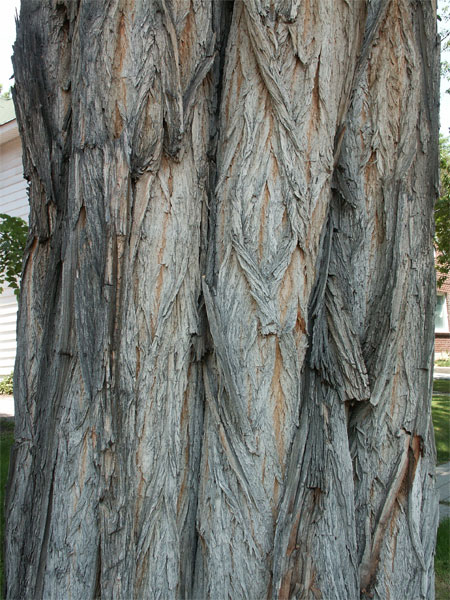Black Locust
Robinia pseudoacacia
Family: Fabaceae or Bean (Pea)
Leaves: Alternate; once pinnately compound; 8" to 14" long; deciduous; 7 to 19 elliptical, ovate-oblong or ovate leaflets, 1-1/2" to 2" long, entire margins, glabrous; dark green in summer; yellow-green fall color.
Twigs/buds: Twigs moderately stout; often zigzag; generally have short, stiff spines, 1/4" to 1/2" long, in pairs at bases of leaves. No terminal bud; lateral buds hidden under cracks of bark near leaf scar.
Flowers/fruit: Flowers perfect, white, 1" wide, pea-like; arranged in 4" to 8" long groups; very fragrant and attractive; flowers in May to early June. Fruit a dark brown, flat legume; 3" to 5" long; containing 4-8 flat brown seeds.
Bark: Red-brown to nearly black; deeply furrowed into cris-crossing scaly ridges; inner bark may be poisonous.
Wood: Moderately important; sapwood yellow; heartwood yellow to golden-brown and rot-resistant; growth rings distinct; ring-porous; rays generally visible to the naked eye; used for fence posts, railroad ties, etc.
General: Native to the central-eastern U.S. Widely planted and naturalized east of the Rockies. Fast growing and well-adapted to a wide variety of sites. Nitrogen fixer. Readily produces sucker sprouts. Shade intolerant.
Landscape Use: An old pioneer tree that is not planted much any more, but should be used, especially under tough conditions. An attractive medium to large-sized tree with a narrow crown and an interesting texture, especially in winter. The attractive, fragrant flowers and the foliage are very nice and the bark is interesting. Unfortunately, it is somewhat pest-prone, with the locust borer especially bad. Zones 3-9.
Comments and Limitations:
- May be insect and/or disease prone, especially when stressed.
- Thorns or spines that can be dangerous; use thornless varieties if possible.
- Sucker (sprout) growth can be a problem.








